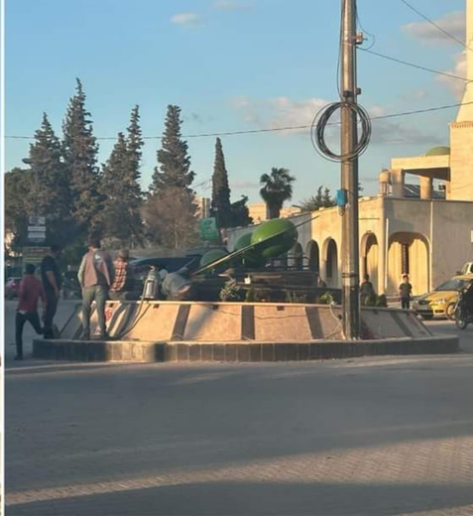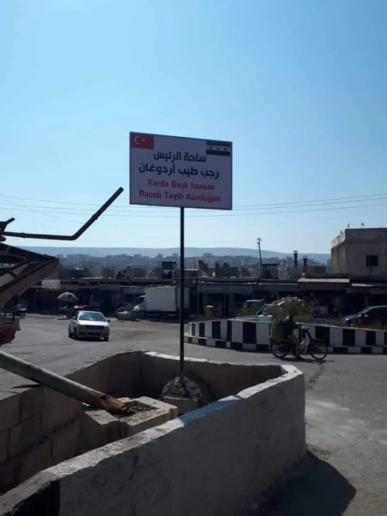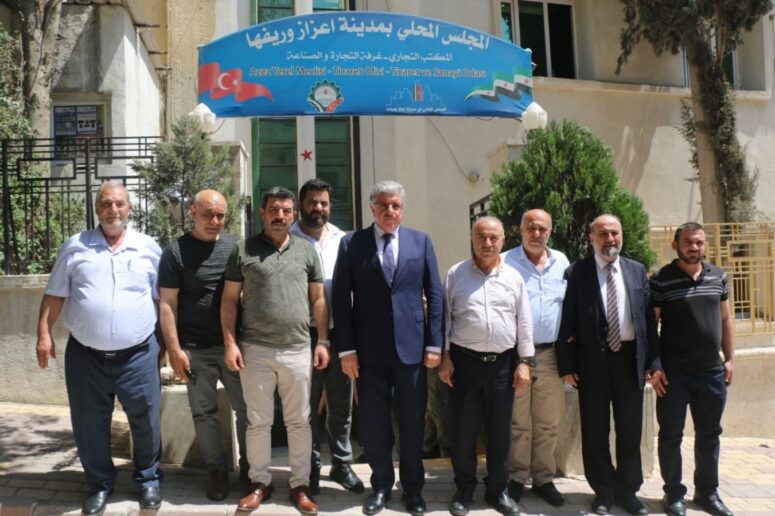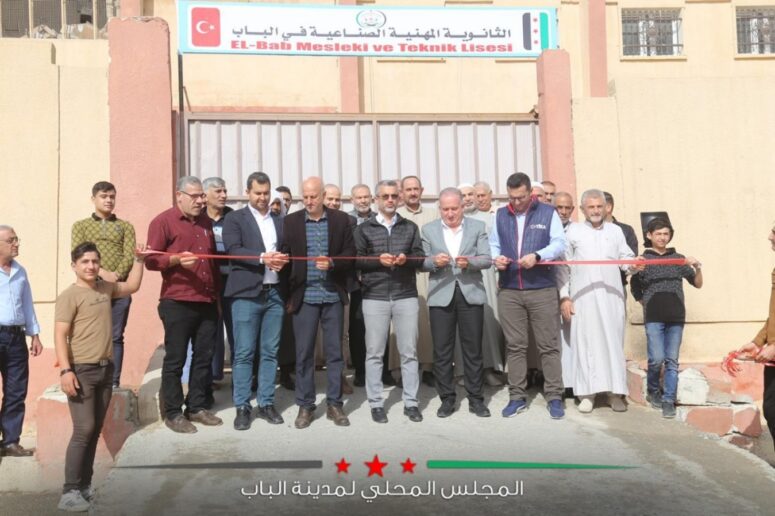On 20 January 2018, Türkiye launched a wide-scale military operation codenamed Operation Olive Branch in the Syrian region of Afrin. The incursion involved approximately 25,000 fighters from the opposition’s Syrian National Army (SNA), lasted 58 days, and ended with the attackers taking control of the overwhelmingly Kurdish area. The operation thus added Afrin to the extensive list of cities and regions under Turkish influence and occupation in northwest Syria, from Jarabulus passing through al-Bab, al-Rai, Marea, and A’zaz.
Since then, Türkiye has begun—through the Syrian opposition factions, local councils, and affiliated political bodies—a process of changing the landmarks of those areas under its control, with the greater impact observed in the Afrin region in northwest Syria. After Türkiye established dominance over Afrin in March 2018, the region has been subject to one of the largest demographic change operations witnessed in the Syrian conflict. The vast majority of Afrin’s local Kurdish population was displaced, and hundreds of thousands of internally displaced people (IDPs), from areas like Damascus and Homs countryside, were settled in their place.
However, Afrin was not the only region to suffer such critical changes, as the remaining areas under Turkish control underwent similar alterations, whereby Turkification also greatly impacted many aspects of their cultural identities.
According to local sources contacted by Syrians for Truth and Justice (STJ) for the purpose of this report, changes in Afrin affected most public facilities, squares, roundabouts, and buildings of departments considered as governmental. In this context, prominent landmarks that indicated Afrin’s Kurdish[ness] were replaced with Islamic or Turkish ones, or others related to the 2018 Olive Branch Operation.
The same sources stressed that these replacements began from the earliest days of Türkiye’s control over the region, by targeting the key landmarks that became iconic of Afrin after 2011, including Kawa al-Hadad (Kawa the Blacksmith) roundabout. The statue welcomed those coming to the region by the main road from Aleppo, passing through A’zaz to Afrin. Notably, the road had been cut off since the beginning of the Syrian conflict due to military operations in Aleppo’s northern countryside between Syrian government forces and the opposition forces then known as the Free Syrian Army.
In this brief report, STJ captures four instances of destruction or Turkification of Kurdish landmarks and structures in Afrin—Kawa al-Hadad Roundabout, Newroz Roundabout, al-Saray Square, and Kurdish-named shops. This is based on interviews conducted by STJ researchers with three local sources in Afrin, one of whom resided in Afrin until 2022, and the other two still residing there, in addition to one testimony taken from a source in al-Bab that touches on the city’s Turkification as well.
All interviews were conducted using a secure communication app. The sources were informed of the voluntary nature of the interview and how the shared information would be used, including publishing this report, after obtaining their informed consent. However, all witnesses requested that their identities or any details that could reveal them not be disclosed, for fear of likely retaliation against them by the armed groups controlling their areas.
As these alterations started in Afrin, there was no reaction from locals, despite the indignation they felt. Locals were and remain unable to express their opinions, given the ongoing arrests targeting them, under alleged ties to the Kurdistan Workers’ Party (PKK), used as justification to detain Kurdish civilians if they show any discontent with the wretched conditions they live in.
From Kawa al-Hadad to Olive Branch Roundabout
The changing of Afrin’s landmarks began within months of Turkish control, through various methods geared toward altering its demographic and cultural structure. This included changing the names of certain places and replacing them with ones indicative of Turkish or Islamic culture, in addition to displacing the local population and replacing it with IDPs from other Syrian areas. Changes also affected the region’s social trends; whereby religious extremism was promoted. All this practices ultimately warranted the dominance of the Turkish and Arab/Islamic culture at the expense of the region’s Kurdish character.
The last of Afrin’s landmarks was replaced in May last year. A sculpture of olives, as a symbol of the Olive Branch Operation, replaced the statue of Kawa al-Hadad, destroyed on 18 March 2018 by placing chains around its neck and dragging it away with a tractor.

An image of the Kawa al-Hadad roundabout after being converted into the Olive Branch roundabout. Source: Kurd Online website
Kawa al-Hadad is a major legendary figure in the Kurdish Newroz (New day) celebrations. According to legends, Kawa was a blacksmith who rebelled against the tyrannical ruler Dahhak, known as Zuhak in Kurdish. After defeating Dahhak, he lit an enormous fire that could be seen from all over the country. Since then, Kurds light fires and celebrate this day as Newroz on the 21st of March each year.
Alan Saeeda,[1] a lawyer from Afrin city, commented to STJ on the changing of these landmarks in in his region:
“The Kurds are attached to the destroyed symbols. The area was known for them. They demolished them not because they had disputes with the previous administration. Those were merely excuses for them to enter Afrin, and their issue is with the Kurds as a whole. This explains the brutality with which they destroyed the statue of Kawa al-Hadad, even though it does not belong to or represent any party. [The statue is] rather associated with the Kurdish people since antiquity and it has been identified by its relations to it and to Newroz.”
In addition, the name of the Newroz Roundabout was changed to Salah ad-Din al-Ayubi Roundabout, an Islamic leader identified by historical sources as having Kurdish origins. Likewise, the name of al-Saray Square, in front of the Legislative Council of Afrin Province, was changed to President Recep Tayyip Erdoğan Square. Notably, the Kurdish names were given to Afrin’s landmarks after the withdrawal of the departments of the Damascus government in 2011-2012, when the People Protection Units (YPG) took control of administering the region until the Autonomous Administration (AA) was officially formed in 2014.
Like Alan, Walat Khelo,[2] who also lives in Afrin’s city center, pointed to changes inflicted on symbolic landmarks in Afrin, including the Kawa al-Hadad and Newroz roundabouts:
“Regarding the landmarks inside the city, they destroyed parts of the Newroz Roundabout and called it Salahdin Roundabout, and the roundabout located across from the governmental Saray, they called it Erdoğan, while they made some changes to the [previous location] of the Kawa Roundabout and called it the Olive Branch Roundabout.”
It was notable that the armed group Army of the East/Jaysh al-Sharqiya known for its widespread human rights violations in the region, also constructed a roundabout and named it after the late Kurdish politician Mashal Tammo, in an attempt to “whitewash” its horrendous record of abuses.

An image of President Recep Tayyip Erdoğan Square in Afrin. Source: Syrian local media outlets and vdc-nsy.
Furthermore, many of the shop names in the center of Afrin, most of which were previously Kurdish, were replaced with names denoting the home places of IDPs, as many IDPs took over large numbers of these shops in the absence of the original owners and lack of transparent means to restore property rights. Alan said:
“The main street from al-Mahmoudiyah down to al-Mehkamah Street, and heading towards Jindires Street and the main street towards al-Saraya al-Qadim, all had their names changed, especially the streets where they [IDPs] opened shops, and all were named with no Kurdish connotation whatsoever, and rather held Arabic names like al-Ghoutani (referencing Ghouta), al-Homsi (referencing Homs), al-Hamawi (referencing Hama) and others.”
For his part Walat said:
“The shops opened by those strangers [IDPs] coming to Afrin were the shops of displaced Afrin residents they had seized, making them food and clothing stores, as well as restaurants, all with indications to Damascus neighborhoods like Ghouta and Jaramana, to the point where we started feeling as if we were in Damascus.”
Afrin’s locals are certain of the objective behind replacing the Kurdish landmarks and accompanying demographic changes in the city. Walat said:
“The goal of changing Afrin’s landmarks is complete demographic and cultural change until Afrin can no longer be called a Kurdish area. When all its landmarks change and are named after Damascus, and around 70% of its population becomes non-indigenous, we cannot claim Afrin is Kurdish, and thus the aim is erasing Afrin’s Kurdish identity.”
Afrin’s residents cannot express resistance to the alterations inflicted upon the area’s cultural identity or its demographic makeup, as they continue to face arrest on mere suspicion from militias of Syrian opposition factions loyal to Türkiye. Regarding this, Shiar Isa pointed out:[3]
“The Kurds are like hostages, exposed to theft of their homes or kidnapping for ransom, and accusations are readily available by a person known as Rami Talas, who had previously headed the Civil Police Directorate. I happened to meet him somewhere in Afrin. Back then, he told us that they have orders to arrest any Kurdish person who dealt with the former Autonomous Administration (AA), and to do whatever pleased them with [those captured], whether imprisonment, torture, or demanding a ransom, and that even those who had no relation to it [AA] can be arrested for being Kurdish, by fabricating charges against them and seizing their shops, or imprisoning or even killing them under torture.”
Turkification in Al-Bab in the So-called Euphrates Shield
These practices aimed at deep cultural eradication are not limited to changing Kurdish landmarks in Afrin, but continue in the form of Turkification even in other SNA-held cities with an Arab majority, such as the city of al-Bab, where the names of key Arab figures, given to schools and other facilities, are replaced with the names of Turkish figures, while Turkish flags continue to be hoisted on public department buildings and facilities.

A photo of a delegation of the Syrian Opposition National Coalition during a visit to the local council in the city of A’zaz on 16 August 2023, showing the Turkish flag displayed on the council’s front sign. Source: The opposition coalition Website

A photo showing the Turkish flag displayed on the front sign of an educational institution in northern Syria. Source: A’zaz Media Center.

A photo capturing the opening ceremony of the Industrial Secondary School in the city of al-Bab in the presence of the Turkish Assistant Director of Education of Gaziantep province. The Turkish flag is seen on the school’s front sign. Source: Local Council of Al-Bab City.
One of the several Turkification incidents in al-Bab occurred in July 2023, whereby a school’s Arabic name, Aminah bint Wahb School, was changed into Durran Kasikin School, who is a Turkish officer killed in Syria. The incident prompted Khalil Abu Shekho, a young man from the city, to confront the matter. He removed the sign with the Turkish officer’s name. However, his action did not pass without consequences as he was arrested after the city’s local council filed a complaint against him.
In this regard, Rami Shafiq,[4] a young man from al-Bab city who was familiar with the details of Khalil Abu Shekho’s arrest, said:
“We were surprised by the local council changing the school’s name upon orders from the Turkish governor, as the council cannot take any action without [the governor’s] instructions. The school’s name was changed from Aminah bint Wahb to the name of a Turkish soldier killed in Syria, Durran Kasikin.”

The photo shows the entrance of Aminah bint Wahb School after the sign with the Turkish officer’s name was removed, which was fixed and reinstalled later. Source: Syrian Observatory.
Rami mentioned that at the time the name of the school was replaced, Arabic signs on the fronts of Syrian stores in Türkiye were being removed:
“Khalil Abu Shekho was immediately investigated, with the Turkish governor himself following up with the investigators over the phone. He was asked about who supported him to act that way, and whether he had removed the name in response to the removal of Arabic signs in Türkiye. Khalil denied [those allegations], stressing the territory [al-Bab] is Syrian and not Turkish, and noting that the reason was that they removed the name of the Prophet’s mother [Aminah bint Wahb] from the school [sign].”
After the Turkish name was reinstated on the school’s front, activist Khalil Abu Shekho was released the next day due to wide popular rejection of his arrest, especially because the local councils in northern rural Aleppo replacement of some school names was widely controversial. The local councils have on various instances replaced Arabic names holding historical, religious, and local symbolic value with Turkish names, including those of fallen Turkish soldiers.
The Free Syrian Teachers Union issued a statement following the incident in al-Bab, condemning the renaming of schools. The statement described the replacement as a provocative act, “indicating ignorance and lack of understanding of reality, as well as a lack of respect for religious and historical symbols,” while also demonstrating disrespect for “the revolution and a people that sacrificed more than a million martyrs and hundreds of thousands of detainees and injured, and millions of displaced people.” The indignation stems from the fact that al-Bab’s incident was not the first of its kind, because the Education Directorates of al-Bab and Bza’a previously changed names of other schools that have existed for decades.
 The photo shows the entrance of Aminah bint Wahb School after the name was changed to Durran Kasikin in al-Bab city. Source: Local activists.
The photo shows the entrance of Aminah bint Wahb School after the name was changed to Durran Kasikin in al-Bab city. Source: Local activists.
Legal Opinion and Analysis
The discriminatory policies pursued by the de facto authorities in areas where Türkiye maintains effective control deeply echo those adopted by the Arab Socialist Ba’ath Party in Syria for decades. While the Syrian government followed an Arabization policy as part of its exclusionary practices against other Syrian groups, especially the Kurdish community,[5] the de facto authorities in those areas follow both Turkification and Arabization policies, including the incidents reported herein, such as changing the names of public squares and schools to Arab or Turkish names irrelevant to the Syrian identity.
Such policies infringe on the cultural, ethnic, linguistic, and religious diversity that characterizes Syria, which the Syrian constitution protects as a national heritage that enhances Syria’s national unity.[6] These policies also contradict the principle of equality among all Syrian citizens established across successive Syrian constitutions, including the 1950 constitution that the Syrian Interim Government (SIG) claims to adhere to because it “represents the revolution” as the SIC’s Minister of Justice once stated.[7]
It is clear that the exclusionary policies practiced by the Turkish government in Syrian territories through SIG-affiliated military factions and local councils aim, as demonstrated by the statements of the report’s sources, to erase the Kurdish identity of areas where such practices occur. This breaches Article 27 of the 1966 International Covenant on Civil and Political Rights, which prohibits depriving persons belonging to minorities of the right to enjoy their own culture. It also violates Article 1 of the 1992 UN Declaration on the Rights of Persons Belonging to National or Ethnic, Religious and Linguistic Minorities, which affirmed the need to protect the existence and identity of minorities and their cultural, religious, and linguistic identities, and the need to create conditions to promote these identities.
In the same vein, the Special Rapporteur on minority issues stressed that protecting and promoting minority identities in the manner stipulated in Article 1 of the aforementioned UN declaration is required not only for the benefit of persons belonging to a minority, but also for the benefit of society as a whole. Therefore, recognizing, protecting, and promoting minority identities is not advantageous to only persons belonging to minority groups, but rather constitutes a major contribution to forming a diverse, vibrant, and more stable national identity.[8]
[1] A pseudonym has been used at the witness’s request during an online interview conducted by STJ’s researcher on 27 May 2024.
[2] A pseudonym has been used at the witness’s request during an online interview conducted by STJ’s researcher on 29 May 2024.
[3] A pseudonym has been used at the witness’s request during an online interview conducted by STJ’s researcher on 11 June 2024.
[4] A pseudonym has been used at the witness’s request during an online interview conducted by STJ’s researcher on 16 June 2024.
[5] For further details, see STJ’s report “Racial Discrimination in the Syrian Constitution”, available at:
https://stj-sy.org/en/racial-discrimination-in-the-syrian-constitution/
[6] Article 9 of the 2012 Syrian Constitution.
[7] For further details, see Enab Baladi’s report “Three judicial systems in northern Syria: What is the extent of their legitimacy and integrity” (in Arabic), available at: https://www.enabbaladi.net/433596/%D8%AB%D9%84%D8%A7%D8%AB%D8%A9-%D8%A3%D9%86%D8%B8%D9%85%D8%A9-%D9%82%D8%B6%D8%A7%D8%A6%D9%8A%D8%A9-%D9%81%D9%8A-%D8%A7%D9%84%D8%B4%D9%85%D8%A7%D9%84-%D8%A7%D9%84%D8%B3%D9%88%D8%B1%D9%8A-%D9%85%D8%A7/

